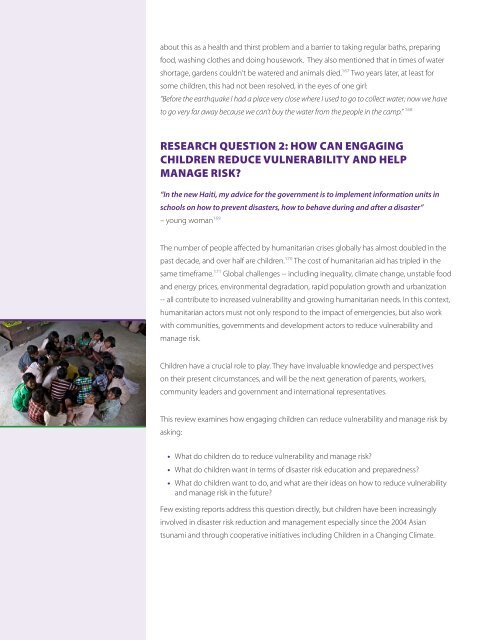putting-children-at-the-heart_full_text_final
putting-children-at-the-heart_full_text_final
putting-children-at-the-heart_full_text_final
- No tags were found...
You also want an ePaper? Increase the reach of your titles
YUMPU automatically turns print PDFs into web optimized ePapers that Google loves.
about this as a health and thirst problem and a barrier to taking regular b<strong>at</strong>hs, preparing<br />
food, washing clo<strong>the</strong>s and doing housework. They also mentioned th<strong>at</strong> in times of w<strong>at</strong>er<br />
shortage, gardens couldn‘t be w<strong>at</strong>ered and animals died. 167 Two years l<strong>at</strong>er, <strong>at</strong> least for<br />
some <strong>children</strong>, this had not been resolved, in <strong>the</strong> eyes of one girl:<br />
“Before <strong>the</strong> earthquake I had a place very close where I used to go to collect w<strong>at</strong>er; now we have<br />
to go very far away because we can’t buy <strong>the</strong> w<strong>at</strong>er from <strong>the</strong> people in <strong>the</strong> camp.” 168<br />
RESEARCH QUESTION 2: HOW CAN ENGAGING<br />
CHILDREN REDUCE VULNERABILITY AND HELP<br />
MANAGE RISK?<br />
“In <strong>the</strong> new Haiti, my advice for <strong>the</strong> government is to implement inform<strong>at</strong>ion units in<br />
schools on how to prevent disasters, how to behave during and after a disaster”<br />
– young woman 169<br />
The number of people affected by humanitarian crises globally has almost doubled in <strong>the</strong><br />
past decade, and over half are <strong>children</strong>. 170 The cost of humanitarian aid has tripled in <strong>the</strong><br />
same timeframe. 171 Global challenges -- including inequality, clim<strong>at</strong>e change, unstable food<br />
and energy prices, environmental degrad<strong>at</strong>ion, rapid popul<strong>at</strong>ion growth and urbaniz<strong>at</strong>ion<br />
-- all contribute to increased vulnerability and growing humanitarian needs. In this con<strong>text</strong>,<br />
humanitarian actors must not only respond to <strong>the</strong> impact of emergencies, but also work<br />
with communities, governments and development actors to reduce vulnerability and<br />
manage risk.<br />
Children have a crucial role to play. They have invaluable knowledge and perspectives<br />
on <strong>the</strong>ir present circumstances, and will be <strong>the</strong> next gener<strong>at</strong>ion of parents, workers,<br />
community leaders and government and intern<strong>at</strong>ional represent<strong>at</strong>ives.<br />
This review examines how engaging <strong>children</strong> can reduce vulnerability and manage risk by<br />
asking:<br />
• Wh<strong>at</strong> do <strong>children</strong> do to reduce vulnerability and manage risk?<br />
• Wh<strong>at</strong> do <strong>children</strong> want in terms of disaster risk educ<strong>at</strong>ion and preparedness?<br />
• Wh<strong>at</strong> do <strong>children</strong> want to do, and wh<strong>at</strong> are <strong>the</strong>ir ideas on how to reduce vulnerability<br />
and manage risk in <strong>the</strong> future?<br />
Few existing reports address this question directly, but <strong>children</strong> have been increasingly<br />
involved in disaster risk reduction and management especially since <strong>the</strong> 2004 Asian<br />
tsunami and through cooper<strong>at</strong>ive initi<strong>at</strong>ives including Children in a Changing Clim<strong>at</strong>e.


